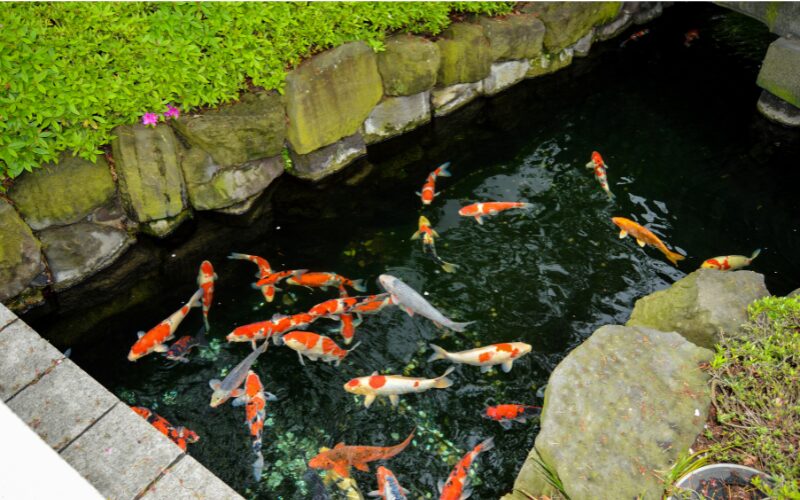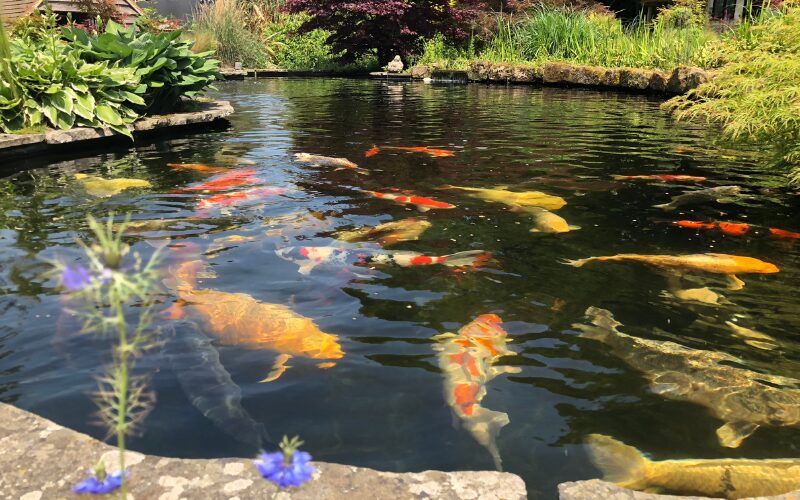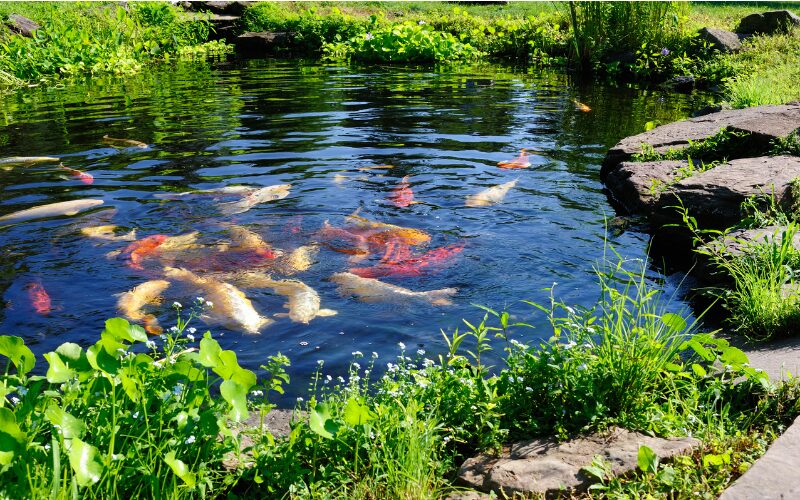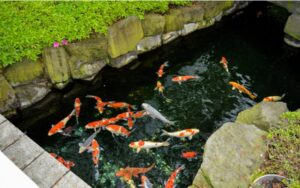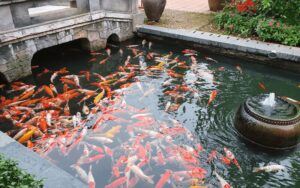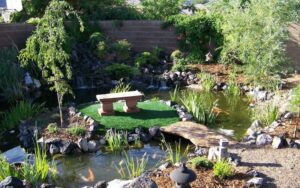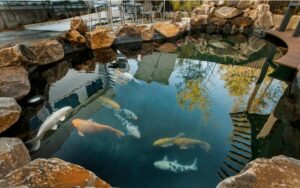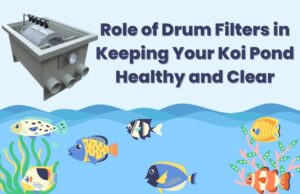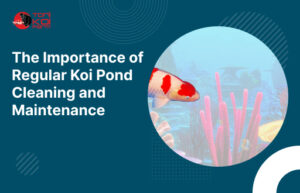Choosing the right size for your koi pond is crucial for the health and well-being of your koi fish. Koi are not just any fish; they are vibrant, colorful, and can grow quite large. Therefore, ensuring they have ample space to swim and thrive is essential. This blog post will guide you through understanding the minimum size requirements for a koi pond, factors influencing this size, design tips, maintenance considerations, and expert insights.
Understanding Koi Fish and Their Needs
Koi fish are known for their beauty and grace. Originating from Japan, they have become a popular choice for garden ponds worldwide. However, their size and active nature require more space than typical pond fish. On average, adult koi can grow to be 2-3 feet long, with some even reaching up to 4 feet. This growth necessitates a larger pond to prevent overcrowding and ensure their well-being.
Factors Influencing Minimum Size Of a Koi Pond
Koi Fish Size and Number
The size and number of koi fish in your pond are primary factors in determining the minimum pond size. A general rule of thumb is to provide at least 250 gallons of water per koi fish. This ensures they have enough space to swim freely and reduces stress.
Example Calculation:
- For 1-2 koi: Minimum 500 gallons.
- For 3-4 koi: Minimum 1000 gallons.
- For 5-6 koi: Minimum 1500 gallons.
Pond Depth
The depth of the pond is just as important as the surface area. A minimum depth of 3 feet is recommended to provide adequate space for the koi to swim and to prevent the pond from freezing during winter. Deeper ponds, around 4-5 feet, are preferable in regions with harsh winters.
Filtration and Water Quality
Proper filtration is vital in maintaining water quality, especially in a koi pond. Larger ponds are easier to manage regarding water quality, as they provide a more stable environment. Investing in a high-quality filtration system can help maintain a healthy pond ecosystem.
Environmental Factors
The local climate plays a significant role in determining pond size. In warmer climates, a larger surface area is beneficial for better oxygen exchange, while in colder climates, a deeper pond is necessary to prevent freezing.
Recommended Minimum Size Of A Koi Pond
Small Koi Ponds
A small koi pond can be a good starting point for beginners or those with limited space. A pond with a minimum capacity of 1000 gallons and a depth of 3 feet can comfortably house 3-4 koi.
Medium Koi Ponds
For hobbyists with moderate space, a medium-sized pond offers more flexibility. A pond with a capacity of 2000-3000 gallons and a depth of 4 feet can accommodate 6-10 koi, providing them with ample space to grow.
Large Koi Ponds
For serious enthusiasts or breeders, a large koi pond is ideal. These ponds should have a minimum capacity of 5000 gallons and a depth of 5 feet or more. Such ponds can house a larger number of koi, providing them with an optimal environment for growth and activity.
Design and Construction Tips
Shape and Layout
The shape of your koi pond can impact its usability and aesthetic appeal. Oval or rectangular ponds are preferred for their ease of maintenance and better water circulation. When designing your pond, ensure it has gentle slopes rather than steep sides to provide a natural habitat for the koi.
Materials and Liners
Using durable materials like concrete, fiberglass, or high-quality pond liners ensures the longevity of your pond. Each material has its pros and cons; for example, concrete is sturdy but can be expensive, while liners are cost-effective but may require replacement over time.
Aeration and Circulation
Proper aeration is crucial for maintaining oxygen levels in the pond. Installing a pond aerator or waterfall feature can help ensure adequate oxygenation. Additionally, designing your pond with efficient water circulation helps prevent stagnant areas and promotes a healthy ecosystem.
Maintenance Considerations
Routine Maintenance
Regular maintenance is essential to keep your koi pond in top condition. This includes routine cleaning, water testing, and checking the filtration system. Seasonal maintenance tasks, such as preparing the pond for winter, are also crucial to ensure the well-being of your koi.
Health Monitoring
Monitoring the health of your koi is vital. Signs of stress or illness, such as erratic swimming, loss of appetite, or visible sores, should be addressed promptly. Overcrowding can lead to stress and disease, highlighting the importance of an adequately sized pond.
Expert Opinions and Case Studies
Insights from koi pond experts emphasize the importance of providing ample space for koi. Real-world examples of successful koi pond setups demonstrate how proper planning and design can lead to thriving koi populations. Testimonials from koi pond owners often highlight the positive impact of a well-sized pond on their koi’s health and happiness.
Key Points
- Provide at least 250 gallons of water per koi.
- Minimum pond depth should be 3-5 feet.
- Proper filtration and aeration are crucial for maintaining water quality.
- Regular maintenance and health monitoring are essential for koi’s well-being.
- Consult experts and consider the local climate when designing your pond.
Recommended Size Of A Koi Pond
| Number of Koi | Minimum Pond Size (gallons) | Recommended Depth (feet) |
|---|---|---|
| 1-2 | 500 | 3 |
| 3-4 | 1000 | 3-4 |
| 5-6 | 1500 | 4 |
| 7-10 | 2000-3000 | 4-5 |
| 11+ | 5000+ | 5+ |
FAQs
How many koi can I keep in a 1000-gallon pond?
- You can keep 3-4 koi in a 1000-gallon pond, ensuring they have enough space to grow and move freely.
What is the ideal depth for a koi pond?
- The ideal depth for a koi pond is 3-5 feet. This depth provides ample space for swimming and helps prevent freezing in colder climates.
How often should I clean my koi pond?
- Regular maintenance, including partial water changes and cleaning the filtration system, should be performed weekly or bi-weekly. Full cleanings can be done annually or bi-annually.
Can I add more koi to my existing pond?
- Adding more koi to an existing pond depends on the current stocking levels and pond size. Ensure you have at least 250 gallons of water per additional koi before introducing new fish.
What are the signs that my koi pond is too small?
- Signs of an overcrowded pond include stressed fish, poor water quality, frequent disease outbreaks, and stunted growth.
Conclusion
Choosing the right size to build a koi pond is essential for the health and happiness of your fish. By considering factors such as the number and size of koi, pond depth, filtration, and local climate, you can create a thriving environment for your koi. Whether you’re a beginner or a seasoned enthusiast, investing in an appropriately sized pond will ensure your koi grow and thrive for years to come. If you have any questions or need personalized advice, feel free to contact us at Torii Koi And Pond. We are here to help you create the perfect koi pond for your needs.

